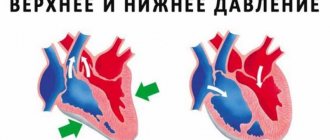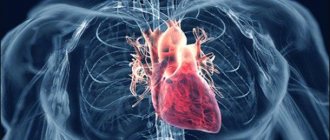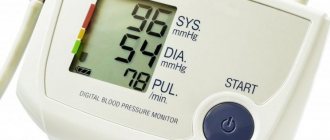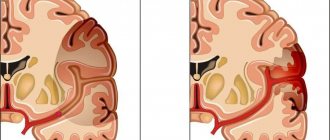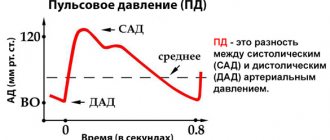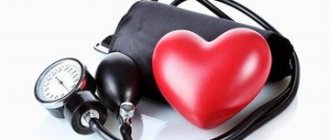What is AD talking about?
Blood pressure is one of the most important functional aspects of the body. At its core, it is the vibration that is recorded at the moment of compression and rarefaction of the heart. The digital values of these parameters are called upper and lower. Diastolic pressure (lower) shows the degree of relaxation of the heart muscle before the upcoming contraction, i.e. with what force does the bloodstream press on the vessels at the end of diastole. An indicator equal to 120/80-140/90 mmHg is considered normal.
What is low diastolic pressure
When exposed to certain factors (stress, illness), blood pressure can change quickly. However, when health stabilizes, blood flow returns to normal. If the lower pressure is low and the upper pressure corresponds to the established limits, then they speak of the development of hypotension. This condition belongs to a number of dangerous diseases, accompanied by complications and disruption of the functioning of internal organs and systems. It requires systematic monitoring and proper timely treatment.
Video on the topic
List of foods that increase blood pressure in the video:
If the situation requires an immediate solution to the problem, then experts recommend using pharmaceutical products. Among these medications, beta blockers should be noted, which can increase diastolic blood pressure without affecting the level of systolic pressure. The most effective among this group of drugs are Concor and Coronal.
The information on the MyMedNews.ru website is for reference and general information, collected from publicly available sources and cannot serve as a basis for making a decision on the use of medications in the course of treatment.
MyMedNews.ru
And we also have
Diagnosis of hypertension, or what kind of examination is needed for high blood pressure?
What does low lower blood pressure mean?
The difference between systolic and diastolic pressure is very significant, therefore, with any deviations in indicators, the heart begins to work more intensely, which negatively affects the functionality of the entire body. Reduced lower pressure indicates a decrease in the tone of the walls of blood vessels, the occurrence of heart pathologies and the development of other diseases.
Main signs of low diastolic blood pressure
If the lower pressure drops sharply to a level of 40 mmHg or less, then this situation is considered critical, requiring emergency medical care. This condition may be accompanied by severe pain in the heart area, difficulty breathing, shortness of breath, pale skin, and numbness of the limbs. In other cases, symptoms of low blood pressure are:
- lethargy, apathy throughout the day, even in the morning;
- headache, dizziness;
- general decrease in performance;
- cold extremities;
- lack of oxygen;
- pale skin;
- causeless vomiting;
- decreased libido;
- frequent fainting.
Symptoms of a Low Top Rate
In 10% of the population, hypotension is genetically predisposed. A pressure of 110 over 70 for a particular person is a normal indicator at which he does not experience unpleasant symptoms. To accurately determine the reduced numbers, it is important to know your normal blood pressure. Changes caused by the influence of external or internal factors are accompanied by:
- headache;
- frequent fatigue;
- vulnerability to depression;
- insomnia;
- nervousness;
- apathy.
Reducing the upper figure to 40-60 mmHg. Art. can be very dangerous and cause fainting. Staying unconscious for a long time can cause death.
Causes
A decrease in vascular tone and disturbances in cardiac muscle contractions can be caused by changes in water and electrolyte balance after bouts of vomiting or diarrhea. Unsystematic use of medications also often becomes a factor provoking arterial hypotension. Doctors identify the following reasons:
- arterial injuries, massive blood loss;
- pulmonary embolism;
- myocardial infarction;
- vegetative-vascular dystonia;
- heart failure;
- hormonal disbalance;
- diseases of the gastrointestinal tract;
- renal failure and other kidney diseases;
- anemia;
- oncology;
- valve dysfunction;
- arrhythmia.
Low diastolic with normal systolic
Hypotension can occur at any age, but older patients are more likely to suffer from this disease. At the same time, they often have such a clinical picture when the lower blood pressure is low, and the upper systolic and pulse are normal, for example, 140/50 mmHg. The reason for this phenomenon is associated with the loss of vascular elasticity, which manifests itself in atherosclerosis.
What is the danger
A decrease in the lower limit of blood pressure to 60 units of calculation indicates the inability of the heart to pump the required volume of blood. Systematic stay in this state requires mandatory medical examination. The fact is that in the absence of proper treatment, hypotension leads to irreversible consequences:
| Danger | ||
| At any age of the patient | In older people | During pregnancy |
| Progression of coronary heart disease | Development of serious cardiovascular pathologies | Impaired blood circulation between mother and fetus |
| Attacks of angina | Disorders of metabolic reactions in the brain | Placental insufficiency |
| Heart attack | Dementia | Slower delivery of oxygen to the baby |
| Stroke | Impaired consciousness, coma | Dysfunction of internal organs in a woman after childbirth |
How to treat?
Therapy consists of taking medications that increase blood pressure, but there are not too many of them. The most famous:
- tincture of eleutherococcus;
- Citramon;
- Chinese lemongrass;
- caffeine sodium benzoate.
If you notice the above symptoms, consult a doctor. He will prescribe you an individual medicine and take all necessary measures to improve your well-being. You should not prescribe a treatment regimen for yourself - this can have a very bad effect on your health.
Get plenty of rest. In the modern world, this may be difficult, but it is extremely necessary for the body to restore its reserves of strength and energy.
What to do if your lower blood pressure is low
If signs of diastolic hypotension appear, you should consult a cardiologist. The doctor will assess the patient’s general well-being and refer him for examination to make an accurate diagnosis and determine the source of the pathology. During the diagnostic process they do:
- electrocardiography;
- MRI (magnetic resonance imaging) of the heart muscle;
- echocardiography;
- biochemical and general blood test;
- Ultrasound of the thyroid gland;
- blood test for hormones.
After studying the results of clinical and laboratory tests, the doctor will prescribe adequate therapy. In addition to medications that normalize low blood pressure, the treatment regimen includes taking medications that eliminate the cause of the disease. In a mild form of the disease, the treatment course will be corrective. To improve health, they may be referred to physiological procedures such as massage, cryo- and magnetic therapy.
In addition, the patient will be recommended some physical activity to strengthen the blood vessels and improve their tone. Restoring the body with lower hypotension is impossible without observing the following rules:
- daily walks in the fresh air;
- playing sports (swimming, light jogging, walking, cycling are recommended);
- maintaining a daily routine, healthy sleep and rest.
Traditional medicine recipes
In the collection of folk recipes there are also many ways to raise the lower level of pressure. It should be noted that any chosen option should not be considered as a panacea, because you cannot get rid of all problems in this way. It is also best to coordinate the use of such prescriptions with your doctor in order to avoid possible side effects and not worsen the condition.
What recipes help raise heart pressure:
- Chicory root has the necessary properties. To do this, you can take a purchased mixture, or brew prepared ingredients yourself. For a liter of water, you need to take four tablespoons of dry crushed root, boil and leave for at least three hours. Take half a glass three times a day.
- Strong black tea with blackcurrant leaves is also an excellent remedy for low blood pressure. For this, a mixture of equal proportions is used, and such a drink should not be used more than three times a day.
- Tincture of dried mulberries, for the preparation of which you need to pour boiling water over a tablespoon of berries. After infusion, this remedy is filtered and divided into three doses per day.
- A decoction of lemons and honey will not only help normalize blood pressure, but also strengthen the immune system. To do this, you need to grind 10 lemons through a meat grinder along with the peel, pour the resulting mixture with a liter of water and leave in the refrigerator for three days. After this period, add 0.5 kg of honey, take 50 grams three times a day. After the mixture is finished, take a month's break and continue treatment.
For a long-lasting effect, the chosen product must be used in courses of three to four weeks. If the expected effect does not occur, you should consult your doctor about further treatment and the advisability of using other folk recipes.
In the prevention of diseases associated with low diastolic pressure, proper organization of work and rest plays an important role. Sleeping at night should take at least eight hours, and continuous work should be alternated with 15 to 20 minute breaks every three hours. In addition, contrast showers, sports and walks in the fresh air are very useful. You should definitely normalize your diet and meal schedule. Giving up bad habits, as well as feasible physical activity, will help maintain healthy blood vessels and strengthen the body.
An alarming condition in which the lower blood pressure level is 50 units or less is life-threatening. At the same time, there is a high risk of heart attacks and strokes, as well as disturbances in the functioning of the vascular system. The causes of low diastolic pressure, its symptoms and methods of treating such pathologies are discussed in our information.
Did you like the article? Save it!
Still have questions? Ask them in the comments! Cardiologist Mariam Harutyunyan will answer them.
Ivan Grekhov
Graduated from the Ural State Medical University with a degree in General Medicine. General practitioner
How to raise lower pressure without raising upper pressure
A prerequisite for maintaining an optimal blood pressure level for a hypotensive patient is a full breakfast. It is better to avoid strong coffee or green tea, although this contradicts established stereotypes, since these drinks do not have a long-term effect and lead to tachycardia. Ginger tea is suitable for these purposes. Medicines prescribed by a specialist will help quickly raise your levels to normal.
Drug treatment
To combat the problem, a complex of drugs is prescribed aimed at stimulating and toning the nervous system, improving metabolic and energy processes in the body. The most effective medicinal groups are herbal adaptogens and nootropics. These include:
- Eleutherococcus is a herbal preparation that has an adaptogenic effect and increases cell resistance. It stimulates nerve receptors, increases performance, relieving symptoms of fatigue and neurosis. The advantage of the medicine is its effectiveness, affordability, and ease of use. Among the disadvantages are the presence of contraindications and the possibility of developing allergic reactions.
- Pantogam is a nootropic agent characterized by neurotrophic, neuroprotective and neurometabolic properties. Excellently improves mental and physical activity, builds brain resistance to hypoxia. The advantages of the drug are that its components are well tolerated by the body and have a wide spectrum of action. Disadvantages - should not be given to pregnant women or people with kidney disease.
- Vasobral is a combination drug that performs dopaminergic and serotonergic functions. With its help, blood circulation improves, red cell aggregation and vascular wall permeability are reduced. Eliminates drowsiness, fatigue, increases blood pressure. The positive side of the substance is considered to be the ability to excite the vasomotor center and enhance metabolic reactions in the brain. The disadvantage of Vasobral is the caffeine content, which can cause sleep disturbances.
Proper nutrition
There are no special diets for normalizing lower diastolic pressure, but products that affect this indicator have been identified. Doctors advise following a diet, not making large gaps in meal times, and drinking plenty of fluids. The diet should be varied, rich in vitamins, minerals, and fiber. The table shows products that help strengthen blood vessels, increase their tone and pressure, and those that it is better for hypotensive patients to avoid:
| Ingredients indicated for low blood pressure | Contraindicated |
| Boiled potatoes | Raw cocoa |
| Nuts | Raw almonds |
| bitter chocolate | Coconut water |
| Fresh juices | Turmeric |
| Fish | Garlic |
| Meat | Spinach |
| Liver | Skimmed milk |
| All types of hot spices, onions | Beans, beans |
Causes
There are many reasons for the development of isolated arterial hypotension.
All factors can be divided into physiological, not associated with diseases, and pathological, associated with the course of diseases of both cardiac and non-cardiac profile.
Physiological factors
- Long-term use of antihypertensive drugs in incorrect dosages or according to the wrong regimen. These medications, especially if we talk about emergency drugs, can provoke the exact opposite reaction. Doctors are partly to blame, patients are partly to blame. More often than not, both. Correction of treatment under the supervision of a cardiologist is necessary.
- Lack of sleep, chronic fatigue. As a result of body fatigue, active production of toxic substances begins, which poison cerebral structures and lead to disruption of blood pressure regulation.
- Insufficient diet. Most often, young girls who suffer from complexes about their appearance “sin” by not eating properly. Exhaustive diets bring nothing to the body except disease.
- Reduced upper blood pressure is possible during puberty (puberty in both sexes), pregnancy (gestation is completely associated with a decrease in blood pressure, sometimes unnatural, asymmetrical), menopause or menopause (both in the fairer sex and in adult men ).
- Low upper blood pressure occurs in athletes, almost all of them. This is a normal reaction of a trained body to excessive physical activity.
- Age characteristics. As a result of the accumulation of the burden of somatic diseases, the development of systolic hypotension in elderly patients is quite possible. Hypertension is more common, but this is not an axiom. All organisms are different.
- In children, isolated hypotension is more common and is a relatively normal phenomenon. However, if you have any suspicions, you should consult a cardiologist for a thorough diagnosis.
- Features of physical activity and activity. Physical inactivity does not have the best effect on blood pressure levels. It is possible to either increase or decrease the tonometer readings.
Pathological causes
Low upper pressure is much more common in functional diseases. What kind exactly?
Long-term heart failure
Accompanied by isolated or classic hypotension, impaired general hemodynamics, tissue hypoxia (oxygen starvation) and impaired functional activity of the heart as a whole.
Read more about chronic heart failure in this article.
Heart attack and early rehabilitation period
It is accompanied by a pronounced decrease in tonometer readings, sometimes only at the upper level, depending on the individual characteristics of the patient’s body and the nature of the process undergone.
Such patients should be managed especially carefully, as fatal relapses are possible. The rehabilitation process after a heart attack is described here.
Hormonal disorders
The cause of low upper pressure may also be hidden in the development of endocrine pathologies. For example, hypothyroidism. That is, a decrease in the concentration of thyroid hormones in the bloodstream.
The causes of the condition itself: insufficiently high-quality nutrition with a low iodine content, thyroid tumors, and other processes.
There may be insufficient amounts of cortisol, a hormone of the adrenal cortex, with the development of tumors, such as pheochromocytoma.
As a result of tumors of the paired gland itself or problems with the pituitary gland, which synthesizes corticotropin. Finally, diabetes mellitus also takes its toll, destroying the body completely.
Development of stroke
It affects the body in the same way as a heart attack. Patients who have suffered an acute cerebrovascular accident require mandatory observation and care. Read about the symptoms of pre-stroke in this article.
Kidney problems
Kidney structures partially synthesize renin. Hence the impossibility of adequate regulation of vascular tone, and changes in tonometer readings within a wide range.
The reasons why the upper pressure is low may lie in pyelonephritis, nephropathies, glomurelonephritis, nephritis and other pathological conditions from the excretory system of the body.
The help of a nephrologist is needed (not to be confused with a neurologist who deals with problems of the central and peripheral nervous system).
Pathologies of blood supply structures in the spinal column
The two most dangerous conditions are: osteochondrosis or hernia of the cervical spine and vertebrobasilar insufficiency.
In both cases, special regulatory centers of the brain do not receive enough nutrients and oxygen, and send chaotic signals, which leads to a distortion of blood pressure levels.
Diseases of the circulatory system
Accompanied by a decrease in hemoglobin concentration. Usually we are talking about iron deficiency anemia with an acute or chronic course.
Regardless of the type and nature of the process, anemia is not limited to an isolated decrease in systolic blood pressure.
A whole range of pathological manifestations develops, including perversion of gastronomic preferences, problems with hair, teeth, skin, and general health.
The state of health deteriorates significantly, which motivates the patient to go to the doctor.
It is impossible not to notice the changes. This is partly a positive thing; it is difficult to miss the required period for treatment.
Bleeding of a long, chronic nature
When the human body constantly loses blood (for example, with a stomach ulcer), it ends in anemia with all the ensuing consequences.
Acute bleeding is potentially lethal and is accompanied by impaired general hemodynamics and tissue ischemia.
The list of reasons is wide, but it is impossible to cover it completely in a short article. Most often we are talking about the listed factors.
